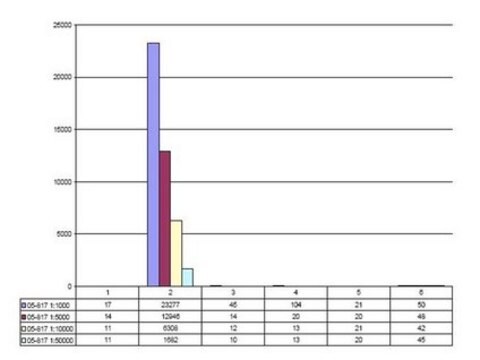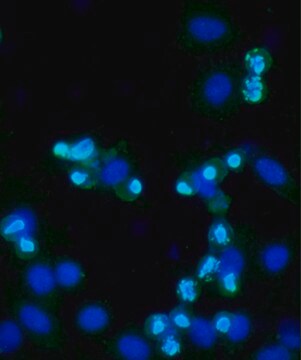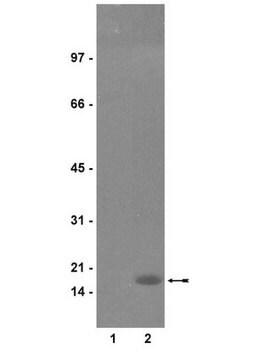07-424
Anti-phospho-Histone H3 (Thr3) Antibody
Upstate®, from rabbit
Synonym(s):
H3T3P, Histone H3 (phospho T3)
About This Item
Recommended Products
biological source
rabbit
Quality Level
antibody form
unpurified
antibody product type
primary antibodies
clone
polyclonal
species reactivity
mouse, human
manufacturer/tradename
Upstate®
technique(s)
immunocytochemistry: suitable
inhibition assay: suitable
western blot: suitable
NCBI accession no.
UniProt accession no.
shipped in
dry ice
target post-translational modification
phosphorylation (pThr3)
Gene Information
human ... H3C1(8350)
General description
Specificity
Immunogen
Application
Evaluated by Western Blotting in acid extract from colcemid-treated HeLa cells.Western Blotting Analysis: A 1:5,000 dilution of this antibody detected Phospho-Histone H3 (Thr3) in acid extract of colcemid treated (50 ng/mL, overnight) HeLa cells, but not the recombinant Histone H3 protein.
Tested ApplicationsPeptide Inhibition Assay: Target band detection in acid extract from colcemid treated (50 ng/mL; overnight) HeLa cells was prevented by preblocking of a representative lot with the immunogen phosphopeptide, but not with non-phosphorylated Histone H3 peptide.Immunocytochemistry Analysis: A 1:500 dilution from a representative lot detected Phospho-Histone H3 (Thr3) in NIH3T3 cells.Note: Actual optimal working dilutions must be determined by end user as specimens, and experimental conditions may vary with the end user.
Quality
Target description
Physical form
Storage and Stability
Analysis Note
Acid extract from colcemid-treated HeLa cells
Legal Information
Disclaimer
Not finding the right product?
Try our Product Selector Tool.
Storage Class Code
12 - Non Combustible Liquids
WGK
WGK 1
Flash Point(F)
Not applicable
Flash Point(C)
Not applicable
Regulatory Listings
Regulatory Listings are mainly provided for chemical products. Only limited information can be provided here for non-chemical products. No entry means none of the components are listed. It is the user’s obligation to ensure the safe and legal use of the product.
JAN Code
07-424:
Certificates of Analysis (COA)
Search for Certificates of Analysis (COA) by entering the products Lot/Batch Number. Lot and Batch Numbers can be found on a product’s label following the words ‘Lot’ or ‘Batch’.
Already Own This Product?
Find documentation for the products that you have recently purchased in the Document Library.
Our team of scientists has experience in all areas of research including Life Science, Material Science, Chemical Synthesis, Chromatography, Analytical and many others.
Contact Technical Service








